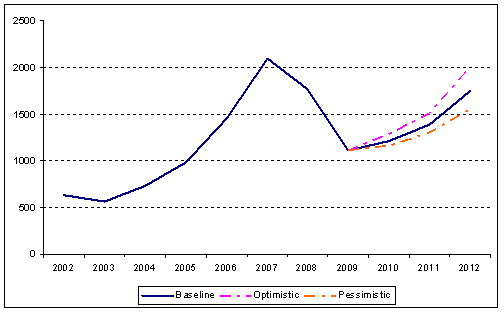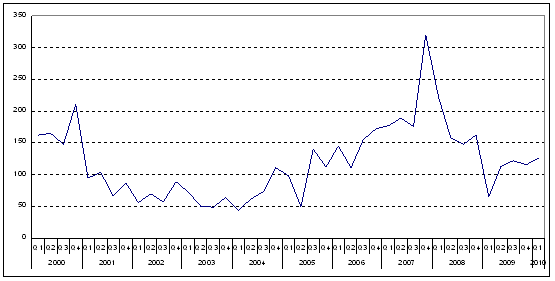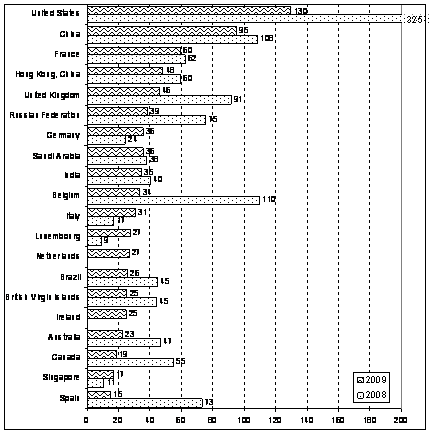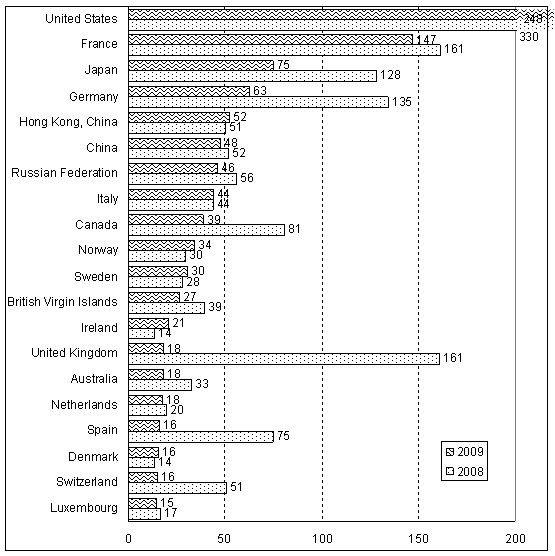| EMBARGO The contents of this press release and the related Report must not be quoted or summarized in the print, broadcast or electronic media before 22 July 2010,17:00 [GMT] (13:00 New York; 19:00 Geneva, 22:30 New Delhi, 02:00 - 23 July 2010 Tokyo) |
Geneva, 22 July 2010 - Global foreign direct investment (FDI) flows bottomed out in the latter half of 2009 and then achieved a modest recovery in the first half of this year, sparking cautious optimism on FDI prospects, reports UNCTAD´s annual study of worldwide investment trends.
The recovery appears set to gather momentum (figure 1), with global FDI inflows expected to pick up to over $1.2 trillion in 2010, rise further to $1.3-1.5 trillion in 2011, and head towards $1.6-2 trillion in 2012. However, these FDI prospects are fraught with risks and uncertainties, including the fragility of the global economic recovery.
The World Investment Report 2010(1) , released today, estimates that FDI inflows worldwide plummeted by 37% to $1,114 billion in 2009 - following a 16% decline in 2008. After this freefall, a timid and uneven recovery appears on its way, thanks to better corporate profits and improved economic and financial conditions. According to a newly introduced quarterly index, global FDI inflows have shown renewed dynamism (figure 2).
During recession-plagued 2009, global FDI outflows fell some 43% to $1,101 billion, outpacing even the 37% drop in inflows. Global FDI declined across the primary, secondary, and services sectors, and most FDI components - equity investment, intra-company loans or reinvested earnings - contracted. FDI by private equity funds decreased by 65%, although flows from sovereign wealth funds rose by 15%. These funds together accounted for one tenth of global FDI flows, compared to less than 7% in 2000, but were down from 22% in the peak year of 2007.
Some major changes in global FDI patterns preceded the global crisis and will most likely gain momentum in the short and medium term, the WIR predicts:
- The relative weight of developing and transition economies as both destinations and sources of global FDI is expected to keep increasing. Although FDI to developing and transition economies declined by 27% in 2009 and FDI outflows from these two groups of economies contracted by 21%, they absorbed almost half of FDI inflows in 2009 and accounted for one quarter of global FDI outflows. These countries are leading the FDI recovery and will remain major destinations for foreign investment.
- The recent further retreat in manufacturing FDI relative to that of the services and primary sectors is unlikely to be reversed. Based on cross-border mergers and acquisitions (M&A) value, the manufacturing sector was the worst affected in 2009, recording a decline of 77% compared to 2008. The contraction in the primary and services sectors was less pronounced on average, at 47% and 57%, respectively. Yet some industries in those sectors were severely affected: the value of transactions in financial services, for instance, plummeted by 87%.
- Despite its serious impact on FDI, the crisis has not halted the growing internationalization of production. During the past two years, the reduction in the value-added of foreign affiliates owned by TNCs was less pronounced than the overall contraction of the global economy. Thus, TNCs´ share in world GDP rose to a historic high of 11%. TNCs´ total foreign employment increased slightly, to 80 million.
In 2009, the slump in cross-border M&As accounted for most of the decline in FDI. Being more sensitive to financial conditions, cross-border M&As contracted by 34% in 2009 (65% in value), compared to 15% in the number of "greenfield" projects -- that is new, from-the-ground-up ventures begun by TNCs in foreign countries. Although FDI flows through both entry modes are showing signs of recovery in 2010, preliminary evidence demonstrates that M&As are rebounding more quickly.
Large emerging markets continued to perform well. Although the United States remained the largest recipient of FDI in 2009, China ranked second. Half of the six top destinations for foreign investment are now developing or transition economies, which also are gaining ground as important sources of global FDI flows (figure 3).
TNCs from developing economies are more optimistic than their counterparts from developed countries and anticipate that their foreign investments will recover faster, the WIR reports. This suggests a continued expansion of emerging TNCs as a source of FDI. In addition, global investors are showing an ever-growing interest in developing economies, particularly in South, East, and South-East Asia. Countries that are especially bright spots for FDI include Brazil, the Russian Federation, India, and China (the "BRIC" countries). FDI flows to developing and transition economies will not only be directed into the most labour-intensive parts of the value chain, but increasingly into more technology-intensive activities, the report says.
Prospects for FDI this year are cautiously optimistic. Only in 2012 is FDI expected to recover to its 2008 level, with a range estimated at $1.6-2 trillion. That is still below the $2.1 trillion peak of 2007. The gradual improvement in macroeconomic conditions, corporate profits, and stock market valuations observed in 2010 is expected to continue over the next few years, supporting renewed business confidence. TNCs´ intentions to pursue foreign expansion appear more robust for 2011 and 2012. The recovery of FDI is likely to take place primarily through cross-border M&As. Restructuring in a number of industries, as well as the privatization of companies rescued during the global turmoil, will continue to create cross-border M&A opportunities for TNCs. Indeed, such M&As rose by 36% in the first five months of 2010 over last year.
This scenario of FDI recovery is far from certain, however. Risks include the fragility of the economic recovery, the uncertain effects of financial regulatory reforms, structural macroeconomic imbalances (for example, fiscal deficits and public debt in many developed countries), limited access to credit, volatility in stock and foreign exchange markets, and possible protectionist measures affecting investment in some countries.
The World Investment Report and its database are available online at http://www.unctad.org/wir and http://www.unctad.org/fdistatistics and http://www.unctad.org/diae |
ANNEX
Tables and figures
Figure 1. Global FDI inflows, 2002-2009, and projections for 2010-2012 (Billions of dollars)
Source: UNCTAD, World Investment Report 2010.
Figure 2. Global FDI Quarterly Index, 2000 Q1-2010 Q1 (Base 100: quarterly average of 2005)
Source: UNCTAD, World Investment Report 2010.
Figure 3. Global FDI flows, top 20 economies,a 2008-2009 (Billions of dollars)
a) FDI inflows

b) FDI outflows

Source: UNCTAD, World Investment Report 2010.
Note: a Ranked on the basis of the magnitude of 2009 FDI flows.


